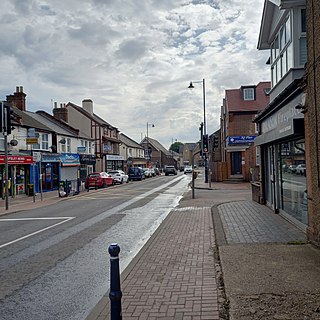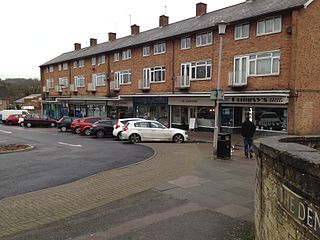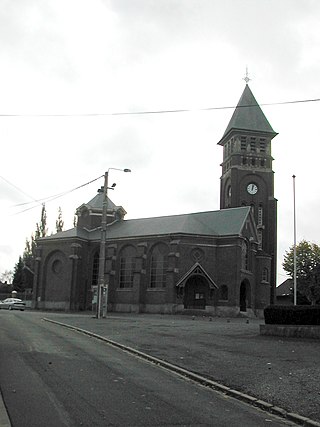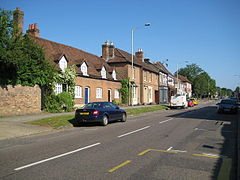
Hertfordshire is a county in the East of England region and is one of the home counties. It borders Bedfordshire to the north and the north-west, Cambridgeshire to the north-east, Essex to the east, Greater London to the south, and Buckinghamshire to the west and the south-west.

Berkhamsted is a historic market town in Hertfordshire, England, in the Bulbourne valley, 26 miles (42 km) north-west of London. The town is a civil parish with a town council within the borough of Dacorum which is based in the neighbouring large new town of Hemel Hempstead. Berkhamsted, along with the adjoining village of Northchurch, is encircled by countryside, much of it in the Chiltern Hills which is an Area of Outstanding Natural Beauty (AONB).

The A41 is a trunk road between London and Birkenhead, England. Now in parts replaced by motorways, it passes through or near Watford, Kings Langley, Hemel Hempstead, Aylesbury, Bicester, Solihull, Birmingham, West Bromwich, Wolverhampton, Newport, Whitchurch, Chester and Ellesmere Port.

Hemel Hempstead is a town in the Dacorum district in Hertfordshire, England. It is 24 miles (39 km) northwest of London, and is part of the Greater London Urban Area. The population at the 2011 census was 97,500.

Apsley was a 19th-century mill village in the county of Hertfordshire, England. It is a historic industrial site situated in a valley of the Chiltern Hills. It is positioned below the confluence of two permanent rivers, the Gade and Bulbourne. In an area of little surface water this was an obvious site for the location of water mills serving local agriculture and from the early 19th century became an important centre for papermaking. Today it is a suburb of the larger town of Hemel Hempstead.

Watford is a town and borough in Hertfordshire, England, 15 mi (24 km) north-west of Central London, on the banks of the River Colne.

Tring is a market town and civil parish in the Borough of Dacorum, Hertfordshire, England. It is situated in a gap passing through the Chiltern Hills, classed as an Area of Outstanding Natural Beauty, 30 miles (50 km) from Central London.

Dacorum is a local government district with borough status in Hertfordshire, England. The council is based in Hemel Hempstead. The borough also includes the towns of Berkhamsted and Tring and surrounding villages. The borough had a population of 155,081 in 2021. Dacorum was created in 1974 and is named after the ancient hundred of Dacorum which had covered a similar area. The borough of Dacorum is the westernmost of Hertfordshire's ten districts. It borders St Albans, Three Rivers, Buckinghamshire and Central Bedfordshire.

Redbourn is a village and civil parish in Hertfordshire, England, lying on Watling Street, three miles (4.8 km) from Harpenden, four miles (6.4 km) from St Albans and five miles (8.0 km) from Hemel Hempstead. The civil parish had a population of 6,913 according to the 2011 Census.

Nash Mills is a civil parish within Hemel Hempstead and Dacorum Borough Council on the northern side of the Grand Union Canal, formerly the River Gade, and in the southernmost corner of Hemel Hempstead. There is evidence of a mill in this location since the 11th century and the row of 16th century mill cottages still remain. John Dickinson established a number of papermaking mills in the area in the 19th century.

Private Christopher Augustus Cox VC, was a British Army soldier and an English recipient of the Victoria Cross (VC) the highest and most prestigious award for gallantry in the face of the enemy that can be awarded to British and Commonwealth forces.

Bourne End is a village in Hertfordshire, England. It is situated on the ancient Roman Akeman Street between Berkhamsted and Hemel Hempstead, on the former A41 London-Liverpool Trunk Route, on the Grand Union Canal that runs between London and Birmingham and at the confluence of the Chiltern chalk stream, the Bourne Gutter and the River Bulbourne. It is in the Dacorum Ward of Bovingdon, Flaunden and Chipperfield.

Abbots Langley is a large village and civil parish in the English county of Hertfordshire. It is an old settlement and is mentioned in the Domesday Book. Economically the village is closely linked to Watford and was formerly part of the Watford Rural District. Since 1974 it has been included in the Three Rivers district.

Chipperfield is a village and civil parish in the Dacorum district of Hertfordshire, England, approximately five miles southwest of Hemel Hempstead and five miles north of Watford. It stands on a chalk plateau at the edge of the Chiltern Hills, between 130 and 160 metres above sea level.

Boxmoor is part of Hemel Hempstead in Hertfordshire. It is within the district of Dacorum and comprises mainly 19th-century housing and meadowland, with transport links from London to the Midlands. At the 2011 Census, the population of Boxmoor was included in the Dacorum ward of Bovingdon, Flaunden and Chipperfield.

Achiet-le-Grand is a commune in the Pas-de-Calais department in northern France.

Hunton Bridge is a small settlement near Abbots Langley, Hertfordshire, England, with a historic royal connection. Its population in the 1991 census was 327. It is in the Three Rivers population of Langleybury.

This article gives brief information on schools that cater for pupils up to the age of 11 in the Dacorum district of Hertfordshire, England. Most are county maintained primary schools, sometimes known as "junior mixed infant" (JMI). A small number are voluntary aided church schools or independent (fee-paying). The Local Education Authority is Hertfordshire County Council.

Potten End is a village in west Hertfordshire, England. It is located in the Chiltern Hills, two miles (3.2 km) east-north-east of Berkhamsted, three miles (4.8 km) north west of Hemel Hempstead and two miles south east of the National Trust estate of Ashridge. Nearby villages include Nettleden, Great Gaddesden and the hamlet of Frithsden. The village is part of the parish of Nettleden with Potten End within the borough of Dacorum.

Kings Langley Palace was a 13th-century Royal Palace which was located to the west of the Hertfordshire village of Kings Langley in England. During the Middle Ages, the palace served as a residence of the Plantagenet kings of England. It fell into disuse sometime during the 16th century and became a ruin. Today, nothing remains of the building except for some archaeological remains. The site is a scheduled ancient monument.

























